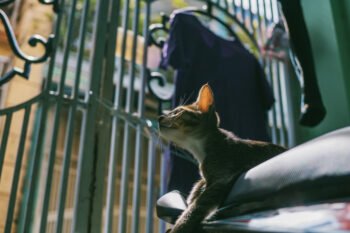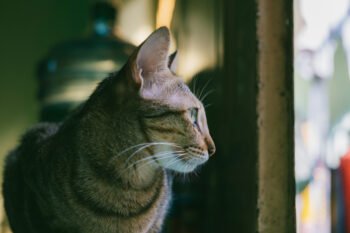If your cat isn’t a party animal, you are not alone. Many felines
shun social events and seem to prefer solitude to human interaction,
which they may fear. This behavior might ruffle your fur since all of
us at times want our buddies to share in the fun and meaningful aspects
of our lives. If your cat’s first inclination is to run and hide, help
is here from Suzanne Hetts, PhD, a Certified Applied Animal Behaviorist
of Littleton, Colorado’s Animal Behavior Associates.
Choose carefully
What you see in a shelter — albeit with
its stressful environment — is likely what you’ll get, especially if
you choose a “feral-background” kitty. If you adopt this type past the
age of ten to twelve weeks, it’s probably not going to be a sociable,
lap-sitting cat. “Characteristics that help a cat survive in the wild
are different from those that make a good companion animal,” says Dr.
Hetts.
Genetics matter
Behaviorists have identified the trait of
boldness, which, when linked to paternal parentage and combined with
socialization, produces the friendliest cats. Dennis Turner, a Swiss
behaviorist, found that the friendliest cats had the same father or
sire. Kittens from bold fathers tend to approach unfamiliar objects,
but they still need socialization. Heredity and environmental
influences are both important.
Socialize soon
Good social skills begin early in life.
Introduce your kitten to cat-friendly adults and children — more than
one new person once a week — from a very young age. The sensitive
period for socialization is between two and seven weeks. “This critical
‘early socialization’ should include gentle handling, including being
picked up,” Dr. Hetts suggests. “Every visitor should dangle your cat’s
favorite toy for a few minutes, or if your cat enjoys treats, bequeath
a few choice morsels.”
Safely widen kitty’s world
Consider promoting supervised,
confined outdoor time so your cat can cope with change in a more
complex environment. A good start is to acclimate your cat as early as
possible to a harness. You may also buy a cat containment system or a
new “kitty stroller” to encourage environmental enrichment. Just be
sure that your cat’s vaccinations are kept up to date if you plan to
safely introduce your kitty to the great outdoors.
Less is more
Try this training tip: Once you’ve played
with or given treats to your cat, ignore it until it approaches you.
“The one who’s not trying to force appears safest to the cat,” says
Hetts. Don’t try to pick up your feline at this point, but instead show
it you know how to behave in “cat company” by using these greeting
techniques:
- Communicate like a cat Use proper cat greeting skills so you
don’t offend your cat’s “social-abilities.” Dr. Hetts explains, “Don’t
rush. Your cat will approach when it’s ready. Curl your fingers in
against your palm (a relaxed fist) and straighten your index finger. A
friendly cat will come up and sniff, then process the scent through a
special organ in its nose and likely sniff a second time. Next, it may
rub against your hand, so reciprocate the rubbing but keep it on its
scent glands — on its cheeks and in front of its ears. You could run
your hand lightly down its spine, but patting from strangers isn’t
usually welcome.” - Lure with treats If your cat is spooked out and
doesn’t make an appearance at all, utilize whatever your feline will
come for, like bagged treats, food in a pouch or…dinner. Ask visitors
to be calmly seated, then you can make familiar sounds, such as running
the can opener or opening/shutting the cabinet door where treats are
kept. Or lay a luring trail of treats from your cat’s hiding spot into
the party place, all the way up to your visitors’ feet. Your cat may
find that too irresistible to pass up. - Be kind Never give your cat a reason to be afraid of
you or other people. Don’t ever spank or hit a cat (or any animal). Why
not try effective discipline delivered remotely and triggered
immediately by the cat’s own behavior, such as a SSSCAT?
It’s a motion detector that sprays a harmless mist in front of your cat
when your cat jumps on it, leaving you innocently out of the picture.
It may take a while before your cat might be ready to party hearty,
and certain felines — similar to humans — retain some of their loner
ways. But try to be patient. Your cat is tuned into your feelings and
actions, so if you are happy and relaxed, those good vibes likely will
rub off on your scaredy cat.







